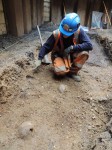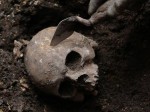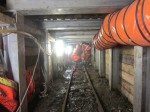 Tunnel diggers excavating next to the Liverpool Street railway station for the £14.8 billion Crossrail project have found 20 human skulls believed to be from the Roman period. Pieces of Roman pottery were found alongside them.
Tunnel diggers excavating next to the Liverpool Street railway station for the £14.8 billion Crossrail project have found 20 human skulls believed to be from the Roman period. Pieces of Roman pottery were found alongside them.
The construction crew was digging a deep pit in which to relocate utility cables when they came across the skulls. Although archaeologists supervise the excavation, the actual digging is being done by professional tunnelers because they’re 20 feet below the surface, underneath the site of the Bedlam cemetery where two years ago more than a hundred skeletons from the late 16th century onward were discovered. The Bedlam cemetery will be fully excavated next year. Archaeologists except to find more than 3,000 bodies which will be careful removed and studied before reburial somewhere where the subway is not.
 The Roman skull were found in clusters, probably because they were swept away by a river and caught in a bend. It’s unusual to find a group of ancient human remains like this outside of a graveyard, and indeed, despite the tempting prospect that they’re the result of a dramatic mass decapitation event, it’s more likely that a burial ground is the source of these remains even though they’re all skulls.
The Roman skull were found in clusters, probably because they were swept away by a river and caught in a bend. It’s unusual to find a group of ancient human remains like this outside of a graveyard, and indeed, despite the tempting prospect that they’re the result of a dramatic mass decapitation event, it’s more likely that a burial ground is the source of these remains even though they’re all skulls.
Lead archaeologist Jay Carver said: “This is an unexpected and fascinating discovery that reveals another piece in the jigsaw of London’s history. This isn’t the first time that skulls have been found in the bed of the River Walbrook and many early historians suggested these people were killed during the Boudicca rebellion against the Romans. We now think the skulls are possibly from a known Roman burial ground about 50 metres up river from our Liverpool Street station worksite. Their location in the Roman layer indicates they were possibly washed down river during the Roman period.”
The Walbrook River is one of London’s lost rivers, a waterway that once divided east and west London that disappeared when it was paved over in the 15th century and the water diverted into a culvert to make way for new construction. Earlier this year the Walbrook gave up an extraordinary 500-year slice of daily life in Roman London, and now it continues to bear fruit underneath Bedlam.
 The skulls have not been dated yet, but experts believe they are probably from the late Roman period — 3rd or 4th centuries A.D. — because before then Romans tended to cremate their dead rather than inhume them. Skulls always travel further than other skeletal remains when they are buried near a moving body of water. They can easily float and their quasi roundness also allows them to roll along river beds.
The skulls have not been dated yet, but experts believe they are probably from the late Roman period — 3rd or 4th centuries A.D. — because before then Romans tended to cremate their dead rather than inhume them. Skulls always travel further than other skeletal remains when they are buried near a moving body of water. They can easily float and their quasi roundness also allows them to roll along river beds.
 Earlier this year Crossrail workers unearthed the foundations of a Roman road made of packed earthed, clay and human bones at the Liverpool Street site. It’s possibly that those human bones the Romans put to such practical use were washed out from the same cemetery that disgorged these skulls into the Walbrook. Romans insisted on human remains being buried outside city walls for religious reasons and for civic health, but they were quite sanguine about bones exposed over time in natural processes, even to the point of putting them to use as construction filler.
Earlier this year Crossrail workers unearthed the foundations of a Roman road made of packed earthed, clay and human bones at the Liverpool Street site. It’s possibly that those human bones the Romans put to such practical use were washed out from the same cemetery that disgorged these skulls into the Walbrook. Romans insisted on human remains being buried outside city walls for religious reasons and for civic health, but they were quite sanguine about bones exposed over time in natural processes, even to the point of putting them to use as construction filler.
Initial osteological examination found the skulls were probably buried in different places. They are different colors of brown and grey, indicating different burial conditions, different minerals in the soil, etc. There is no immediate evidence of foul play, although more detailed analysis will have to be done to confirm that. Stable isotope analysis on their teeth will hopefully answer questions about where the people came from and what they ate.
[youtube=http://youtu.be/YPrscxWT_EA&w=430]
That is interesting.
:hattip:
The likelihood of these skulls being washed from a graveyard, 20 of them, at a bend in the river, is too coincidental for my curiosity. Being intentionally discharged into the river, and then washed downstream makes entirely more sense without having to recite the physical principle of how a skull can ‘float and roll’ through a water current. ‘Key’ here is the complete absence of other bones, or parts of, that would sensibly exist with the skulls also.
The skulls would have floated below the surface of the water, but not visible, for a period of time shortly after the beheadings. In a more likely scenario, a freshet, in a opportune time frame, would have washed the skulls to a place of entrapment as in a bend in the river. Therein, followed by a short period of time, the skulls would fill with debris and sediment and become immovable in a surrounding cementitious muck. :skull: